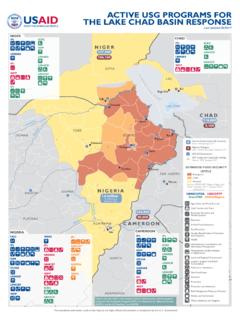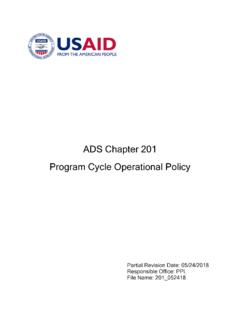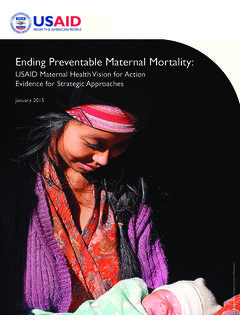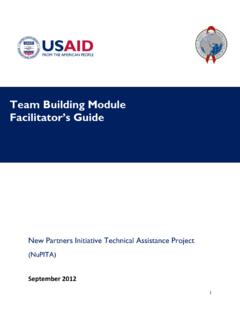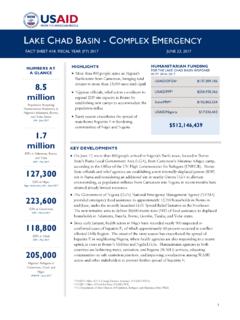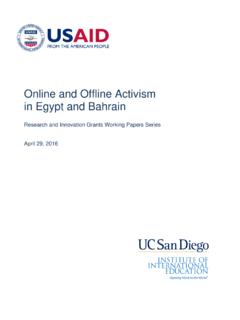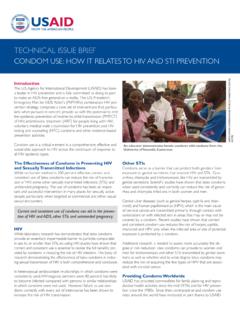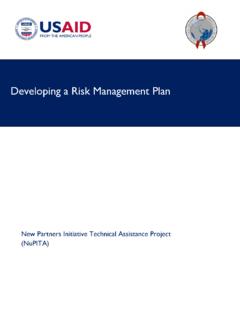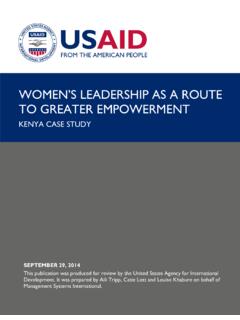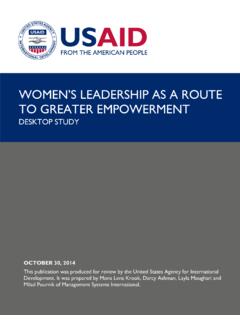Transcription of POST-HARVEST HANDLING AND STORAGE (PHHS) PROJECT
1 POST-HARVEST HANDLING AND STORAGE (PHHS) PROJECT FINAL REPORT POST-HARVEST HANDLING AND STORAGE (PHHS) PROJECT FINAL REPORT This final report was produced for review by the United States Agency for International Development. It was prepared by Nathan Van Dusen and Kristin Beyard for CARANA Corporation. The authors views expressed in this report do not necessarily reflect the views of the United States Agency for International Development or the United States Government. Table of Contents Table of Contents .. v Introduction .. 1 Private Sector Strategy .. 7 Component 1: Market Linkages Support .. 7 World Food Programme Partnership .. 8 Market Information Systems .. 9 value chain Analyses and Targeted BDS& Market Linkages Support .. 11 Component 2: Investment Finance .. 14 Strategic Partnerships through Co-Investment Grants .. 14 Merchandizing Credit .. 16 Component 3: POST-HARVEST Management.
2 19 POST-HARVEST Management Training/Sell More For More .. 20 Cooperative Leadership Training .. 21 BDS 22 Public Sector Strategy .. 27 Component 4: POST-HARVEST Strategy Development .. 27 MINAGRI Advisory Support .. 28 POST-HARVEST Loss Assessment .. 29 Esoko Assessment and Strategy .. 31 Advocacy Platform .. 31 Strategic Grain Reserves Manual .. 32 Annex I: Performance Monitoring Plan (PMP) .. 34 Introduction Agriculture drives the Rwandan economy, accounting for 80% of employment, 36% of GDP, and 63% of foreign exchange The agricultural sector has seen rapid growth in recent years with large increases in production achieved by smallholder farmers, 95% of whom have farms that are less than two hectares in This fragmented production base leads to serious challenges in getting product to market efficiently and integrating farmers into commercial marketing channels that allow for differentiation.
3 Among the impacts of fragmentation, small farmers lack the capital and know-how to efficiently harvest, store and market their surplus yields. MINAGRI estimates between 15% and 22% POST-HARVEST losses in cereals as a result. Losses impact producers and consumers, reducing farmer incomes and raising consumer prices as a result of diminished supply. As part of the Global Food Security Response and Feed the Future Initiatives, USAID s POST-HARVEST HANDLING and STORAGE (PHHS) PROJECT set out to integrate farmers into commercial marketing channels as a way of driving investment in POST-HARVEST technology and process improvements for staple crops, particularly maize, beans, and rice. The PROJECT took an integrated public-private approach to reducing POST-HARVEST losses and improving food security. CARANA piloted new approaches and innovations to engage policy makers, banks, civil society, cooperatives and smallholder farmers.
4 These pilots contributed to developing a market system in Rwanda that encouraged farmers to supply higher quality grain, and built the capacity of local stakeholders (both private and public) to adopt and sustain these pilots, contributing to a more efficient staple crops value chain . The PHHS PROJECT s implementation model allowed it to be responsive to government priorities and enabled Rwandan policy makers to incorporate lessons and realities from the private sector into their POST-HARVEST policy framework. 1 World Bank, PROJECT Appraisal Document on a Proposed Grant to the Republic of Rwanda for a Rwanda Second Rural Sector Support PROJECT in the Second Phase of the Rural Sector Support Program, World Bank, June 2008. 2 Morel-Seytoux, Sylvie H. Lalonde. Gender Assessment and Action Plan for USAID Rwanda, WIDTech, Washington, District of Columbia, March 2002. POST-HARVEST , HANDLING , AND STORAGE (PHHS) PROJECT : FINAL REPORT 1 This report summarizes the evolution of the PHHS PROJECT in terms of objectives, activities and achievements in addition to presenting lessons learned for future programs with similar objectives.
5 The report covers the period of the original PROJECT (September 2009 through March 2012), in addition to the 18-month extension through August 2013. Methodology and Objectives PROJECT activities, sectors and objectives were identified in the first two quarters of the PROJECT . PHHS carried out an opportunity mapping of sector and activity level priorities in Rwanda s commodity value chains, and as a result, developed an Inception Report in April 2010. The report examined the current situation in Rwanda with respect to market linkages, POST-HARVEST investment promotion, and POST-HARVEST management for the six targeted staple crops (maize, rice, wheat, beans/soybeans, cassava and Irish potato ). Meetings were held with the major buyers/processors of staple crops, which revealed that with the exception of cassava and Irish potato , the supplies of staple crops did not meet market requirements with respect to necessary volumes and required standards.
6 In the development of this report, meetings were held with umbrella organizations and private sector entities working with farmers cooperatives to learn what sort of assistance is being provided to producers, as well as what constraints farmers encounter from production to marketing. Information was gathered on the regions which have the largest volumes of surpluses for each of the six targeted crops, and an assessment was made of existing POST-HARVEST infrastructure. Trips were also made to the field to visit farmers in several districts of Rwanda, which revealed that farmers need ed capacity building with respect to improved harvest and POST-HARVEST HANDLING practices. 2 SEPTEMBER 2013 PROJECT Objectives The inception report prioritized maize, beans and rice as the commodities that domestic producers were most likely to be able to market successfully through commercial channels.
7 A s a result, PHHS objectives have been defined as follows: Mobilizing private investment and bank finance to develop businesses that require STORAGE infrastructure; Improving management and HANDLING of staple crops by farmers, in partnership with agribusiness firms and Rwandan business development service providers through a market-driven approach; Developing more robust linkages between farmers and the market by connecting producers to premium markets through intensive training by the Sell More for More Training team and other innovations including an online GPS map of producer cooperatives and Market Information System pilots; Assisting farmer associations/cooperatives to expand their own warehouse infrastructure and availability of working capital through business plan development and finance training courses to attract private bank finance; Increasing MINAGRI s capacity to widen its medium-term strategy for the development of Rwandan staple crops through improved marketing and POST-HARVEST activities; and Identifying specific market-led interventions that can be adopted by individual players within the value chain to reduce POST-HARVEST losses in staple crops, including investments by buyers in supply chain constraints.
8 Budget $ million Duration 4 years : September 2009 through August 2013 Components 1. Market Linkages and Business Development 2. Investment Finance 3. POST-HARVEST Management 4. Post- Harvest Policy Targeted Staple Crops Maize, Beans and Rice Geographic Coverage Throughout Rwanda with a focus on Northern and Southern Provinces POST-HARVEST , HANDLING , AND STORAGE (PHHS) PROJECT : FINAL REPORT 3 PROJECT Component Areas The scope of work for the PHHS PROJECT is comprised of four key components: 1) Market Linkages with firms that will result in strategic partnerships to develop business ventures and invest in POST-HARVEST HANDLING and STORAGE ; 2) Investment Finance that will result in strengthening supply and incomes within the maize and bean value chains; 3) POST-HARVEST Management that will lead to better HANDLING practices for farmers seeking higher prices for better quality commodities.
9 And 4) POST-HARVEST Policy support to the Government of Rwanda with the intent to improve the business environment for the private sector. 4 SEPTEMBER 2013 PROJECT Achievements During the years of the PROJECT , PHHS has achieved the following results: 83,676 farmers are now using STORAGE centers through PHHS Assistance. 104 STORAGE centers were constructed or rehabilitated. $ million USD of new investment was made in private agribusiness, particularly cooperatives, aggregators, processors and millers. BDS support was provided to 59 SMEs and direct assistance to 358 private enterprises. Over 60,000 farmers were trained in POST-HARVEST HANDLING and STORAGE best practices. 3 policy strategies focused on improving the enabling environment at the POST-HARVEST and marketing levels were drafted; one of these strategies, the POST-HARVEST strategy was adopted by government.
10 Furthermore, the PROJECT piloted new innovations and activities that have shown impact and sustainability within Rwanda, including new financial products, capacity building methodologies, policy frameworks, and market information systems, to name a few. Many of these pilots are now being adopted by local entities to expand and scale. Additionally, the co-investment grant activities have enabled SMEs with new business ideas to access financing to pilot business practices and investments that have led to increased returns and additional financing from commercial banks and private sector investors. POST-HARVEST , HANDLING , AND STORAGE (PHHS) PROJECT : FINAL REPORT 5 Private Sector Strategy In developing the PHHS PROJECT s private sector strategy, CARANA collaborated with strategic buyers including the WFP and large private sector millers and aggregators to identify their needs and opportunities for improving smallholder integration into their supply chains.
